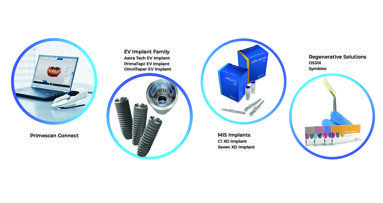What’s measured is improved. Consistent, measured improvement in dentistry relies on tracking key metrics (KPIs), and new tools, such as a dedicated dental analytics platform and dental dashboards, can help make that possible.
Data overwhelm is real, yet your ongoing ability to provide the highest care standards requires that you track your organization’s health. While you shouldn’t track every tedious strand of data, you can focus on those key areas that drive your success as a dental provider. Your ability to visualize and interact with your core data categories keeps you informed and invested in your patient’s care outcomes.
Below are four key KPIs a dental analytics platform should help you track.
1. Incoming patients
Patient flow (or volume) data gives you perspective about who you’re treating, when and how long, and how they’re connecting with you.
Think of your fundamental patient data this way:
- How many patients and what type of treatment?
- When are they scheduling and what’s the duration of their visit?
- How did they find you and/or who referred them?
This layer of patient data gives you valuable insight into your community’s awareness about your services, how you attract or market to them and what health outcomes they’re trusting you to provide.
2. Revenue streams
The lifeblood of your organization is consistent revenue flow. Financial leaks or mismanaged resources and opportunities can (no doubt) hinder patient care.
It makes sense to give attention to revenue stream KPIs:
- Who is cancelling appointments or no-showing?
- Who requires a referral outside of your office/practice?
- Who is being rescheduled because of your (provider) schedule or unavailability?
Strategies for reminders, rescheduling and follow-up can be supported within a dedicated dashboard category.
3. Services provided
It’s helpful to know what type of services your patients are utilizing. Alongside that data is having perspective on outcomes such as referrals and specific department resources that are being used.
Drill down into key specifics such as:
- The number of appointments you/provider pool is completing.
- What extended services (e.g. surgery, etc) are being provided and by whom?
- The appointments that are being scheduled within each department or specialty service.
Your utilized services can reveal useful data about patient need and preference. An equipped dashboard will cross-section your patient data around demographics that could produce improved or new service opportunities.
4. Income generators
Consider this KPI to be a deeper dive into your revenue stream. It focuses more on what’s driving your income.
- Per provider.
- Per department/team.
- Per service or specialty.
Your profitability forecast and reality depend on the informed decisions you make around your discoveries. The same applies to all related areas of your patient care environment.
A dental analytics platform with KPI dashboard
Why not use an all-in-one dental KPI dashboard for maximizing DSO, group practice and solo private practice patient care data?
Jarvis Analytics:
- Integrates seamlessly with your chosen practice management software/platform.
- Presents the metrics you want and need in an easy-to-view dental dashboard that reduces data complexity for growing dental practices, dental groups and DSOs.
To learn more about how Jarvis Analytics can help you, you can request a demo at JarvisAnalytics.com.
(Source: Henry Schein One)
Tags:
We hear about it a lot these days — dental practices getting squeezed by lower consumer spending. The result is less treatment acceptance and lower ...
OrthoFX, a leading innovator in the clear aligner industry, is changing the paradigm of midcourse corrections. Ren Menon, OrthoFX co-founder, said: ...
CVM Health recently introduced three innovative communication tools for dental clinics. The first tool is an educational digital signage solution ...
DS Signature Workflows are designed to simplify and enhance every implant treatment. With these latest innovative solutions and one ecosystem for products ...
Any established dental practice has thousands or tens of thousands of patient records. These active and inactive patients are ready and waiting to be ...
When consumers fire up their web browsers, the vast majority of them start at a search engine. According to research from Pew Internet, 93 percent of online...
DENVER, Colo., USA: When it comes to anything involving digital technology, the folks at Henry Schein Dental have you covered. Under ConnectDental, ...
In traditional practice, occlusal splint fabrication was generally delegated to the dental laboratory. Common fabrication methods are printing and milling. ...
In these extraordinary times many dental offices are closed or dramatically reducing hours to help protect patients and staff and conform to local/state ...
Your journey as a dental professional begins with the hopes of having the best possible outcome. Yet once you are out of school, as many have experienced, ...
Live webinar
Wed. 14 January 2026
12:00 PM EST (New York)
Dr. Théo Laplane, Dr. Robert Gottlander DDS
Live webinar
Fri. 16 January 2026
12:00 PM EST (New York)
Live webinar
Mon. 19 January 2026
1:00 PM EST (New York)
Philipp Kopp, Michael Seeber
Live webinar
Thu. 22 January 2026
9:00 AM EST (New York)
Prof. Judith Jones D.D.S; M.P.H., Prof. Kakuhiro Fukai D.D.S., Ph.D, Dr. Bathsheba (Bethy) Turton
Live webinar
Thu. 22 January 2026
2:00 PM EST (New York)
Dr. Nicola M. Grande DDS, PhD
Live webinar
Wed. 28 January 2026
8:00 AM EST (New York)
Live webinar
Wed. 28 January 2026
11:00 AM EST (New York)
Prof. Dr. Jan-Frederik Güth



 Austria / Österreich
Austria / Österreich
 Bosnia and Herzegovina / Босна и Херцеговина
Bosnia and Herzegovina / Босна и Херцеговина
 Bulgaria / България
Bulgaria / България
 Croatia / Hrvatska
Croatia / Hrvatska
 Czech Republic & Slovakia / Česká republika & Slovensko
Czech Republic & Slovakia / Česká republika & Slovensko
 France / France
France / France
 Germany / Deutschland
Germany / Deutschland
 Greece / ΕΛΛΑΔΑ
Greece / ΕΛΛΑΔΑ
 Hungary / Hungary
Hungary / Hungary
 Italy / Italia
Italy / Italia
 Netherlands / Nederland
Netherlands / Nederland
 Nordic / Nordic
Nordic / Nordic
 Poland / Polska
Poland / Polska
 Portugal / Portugal
Portugal / Portugal
 Romania & Moldova / România & Moldova
Romania & Moldova / România & Moldova
 Slovenia / Slovenija
Slovenia / Slovenija
 Serbia & Montenegro / Србија и Црна Гора
Serbia & Montenegro / Србија и Црна Гора
 Spain / España
Spain / España
 Switzerland / Schweiz
Switzerland / Schweiz
 Turkey / Türkiye
Turkey / Türkiye
 UK & Ireland / UK & Ireland
UK & Ireland / UK & Ireland
 International / International
International / International
 Brazil / Brasil
Brazil / Brasil
 Canada / Canada
Canada / Canada
 Latin America / Latinoamérica
Latin America / Latinoamérica
 China / 中国
China / 中国
 India / भारत गणराज्य
India / भारत गणराज्य
 Pakistan / Pākistān
Pakistan / Pākistān
 Vietnam / Việt Nam
Vietnam / Việt Nam
 ASEAN / ASEAN
ASEAN / ASEAN
 Israel / מְדִינַת יִשְׂרָאֵל
Israel / מְדִינַת יִשְׂרָאֵל
 Algeria, Morocco & Tunisia / الجزائر والمغرب وتونس
Algeria, Morocco & Tunisia / الجزائر والمغرب وتونس
 Middle East / Middle East
Middle East / Middle East




























































To post a reply please login or register